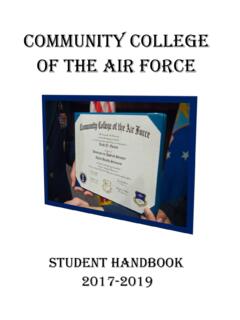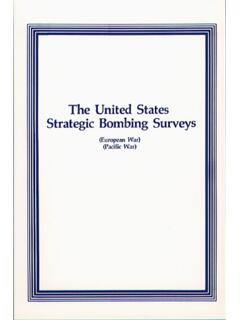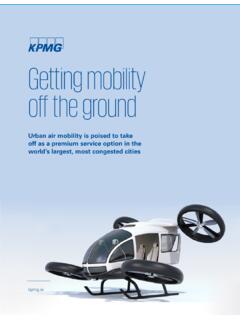Transcription of Air Power FORWARD - Air University
1 "Air Power " Airpower is the most difficult of all forms of military force to measure, or even express in precise Churchill FORWARD Churchill's insight is as valuable today as it was decades ago. This is especially evident in discussions that attempt to agree on the definition of "air Power ." We in the Air Force seem to have a notion of what air Power is, and specific ideas on it as applies to our particular specialty. But as the Chief of Staff, General Fogleman, has reminded us on several occasions, we have become too stovepiped and miss the bigger view of how our entire Air Force accomplishes its mission as part of the joint team. A logical point of departure for understanding the bigger picture is to begin with an understanding of the basics. This brings the discussion back to Churchill and his observation of the difficulty in expressing air Power in precise terms. With this in mind, and as a point of departure, the following definition of air Power is offered: Air Power is the integrated employment of all air and space forces to control and exploit the air and space environments to achieve national security objectives.
2 Air Power exploits the properties of its operating medium to realize unique operational characteristics and thus employ unique capabilities to provide the nation a broad range of military options. This essay is the result of discussions on roles and missions, core competencies, institutional identity, and similar topics. It is the result of disagreements on some of the most basic elements of our profession. Air Force people "out in the trenches" will probably not care much about the meaning of air Power . For that matter, most would probably question the notion that there isn't a common understanding of air Power --that's okay. However, those Air Force people who are in positions deciding on what the future Air Force should look like, how it should be employed, what equipment it buys, what missions it gets into, the priorities it gives to emerging missions, and similar decisions, absolutely must understand air Power .
3 As the fog of political debates, budget battles, and service policy dilemmas cloud the air, Air Force decision makers, military and civilian, must maintain a clear bearing on what the Air Force is about. What the Air Force is about, is air and space Power . Thus the author is compelled to exercise the privilege of "having a say," at least about air Power . Many readers may very likely not agree with the ideas expressed here --and that is okay. Air Power Billy Mitchell defined air Power as "the ability to do something in the air." Although Mitchell seems to have provided a simple and direct definition of air Power more than 70 years ago, the meaning of air Power remains an issue of debate yet today. Within the Air Force, airmen and scholars alike remain unable to define air Power in terms that all can agree upon. To complicate and further confuse the issue are related issues of core competencies, and roles and missions.
4 Amid the debate is the search for an institutional identity within the Air Force. At the root of all these, and related issues, is the question of the meaning of air Power . To understand air Power requires a fundamental understanding of the terms "air" and " Power ." "Air" is the envelope of atmosphere surrounding the earth; as a medium it singularly covers the entire earth. Power can be described as the ability or capacity to perform effectively. To understand "air" as an operating environment is fundamental to understanding the characteristics of air Power . Understanding " Power " serves as a means of identifying the capabilities of air Power . Properties of the medium An understanding of the characteristics of air Power must begin with an understanding of "air." "Air," for the purpose of defining air Power , is the atmosphere. The air has certain immutable properties that provide air Power with defined characteristics.
5 The fundamental properties of the atmosphere are: 1) it has few natural obstacles, 2) it covers the globe, and 3) it has vertical depth. Although it may be possible to list further properties of the atmosphere, these are the most fundamental ones from which others are derived. The three fundamental properties of the atmosphere enable three fundamental characteristics of air Power : 1) speed, 2) range, and 3) elevation. Although other characteristics are, have been, and will be expressed, they are nothing more than a product of one or more of the fundamental characteristics of speed, range, and elevation. Characteristics of air Power The air has few natural obstacles thus making possible the speed of aircraft. The air environment has only one distinct boundarythe earth's surface. Aircraft operate above this boundary, however, and it cannot be considered a natural obstacle for normal operations . The atmosphere has another, indistinct boundary, defined by the thinning of the atmosphere at higher altitudes.
6 Between these two boundaries lies the air within which aircraft operate. Within this density of air, except for extreme weather phenomena, there are no natural barriers to significantly impede aircraft. Because there are few obstacles, air vehicles can achieve unparalleled speed. It is singularly the lack of obstacles that makes speed possible. Were there obstacles in the air, they would slow air vehicles in the same way as mountains and rivers impede surface movement. The lack of obstacles makes speed possible. By way of example, consider two equal world class spinters on a straight 100 meter track. Given equal conditions, both sprinters would likely finish with seconds of each other, and both achieve their maximum speeds. Now, place hurdles in one lane while leaving the other lane open. The sprinter with the open lane will achieve maximum speed over the course, while the sprinter facing the obstacles will be slowed down, whether going over, around, or under the hurdles.
7 Physical obstacles slow movement, whether it is an obstacle course, a mountain, or a swamp. The air has few obstacles and thus air vehicles can achieve speed unmatched by surface movement over, around, or under these obstacles. The air covers the entire earth's surface making possible the range of aircraft. Air vehicles can travel along any route of air, to any point covered by air, from any point covered by air. The distance between the points is of no consequence as long as the air connects the two. Range then, is also of little consequence for air vehicles. Technology presents challenges to the range of aircraft because of their dependence on fuel to sustain flight, but it also provides solutions with in-flight refueling and greater efficiency engines. Range is not a function of speed, as speed affects only the relative measure of the time it takes the aircraft to travel the required range.
8 It is singularly the ubiquity of air, the fact that it envelopes the earth that makes range possible. The nonstop, non-refueled flight of the Voyager aircraft around the globe in December of 1986 illustrates the range possible by the ubiquity of air. Were air limited to only an area of the earth's surface, then an aircraft's range would be equally limited to this restricted area. This point is evident when considering the vertical range of aircraft rather than the horizontal range. Aircraft cannot travel any further vertically than the limit of the atmosphere. Where the air stops, the aircraft stops, having neither air to sustain lift nor propulsion. The range of the aircraft is thus limited. Operating within the lateral dimensions of the atmosphere provides for unparalleled global range. The air medium allows unlimited access to the entire earth's surface. Air and space forces are able to range over land and sea boundaries without difficulty, because the air is ubiquitous.
9 The air has vertical depth making possible elevation. Because the air exists between its surface boundary and some upper limit, it has immense vertical depth. Aircraft, exploiting this depth are free to maneuver vertically. Although this point may appear obvious, many times this characteristic is confused with "perspective" or "freedom of maneuver." Perspective describes the result of elevation rather than the characteristic of elevation. Because the atmosphere has depth, aircraft can maneuver to achieve height and thus gain perspective. Because the atmosphere has depth, aircraft can gain elevation, thus realizing an increased freedom of maneuver. This again, however, describes the result of elevation and not the characteristic. The uses of elevation are many, but the characteristic of elevation is made possible, singularly because of atmospheric depth. The fundamental properties of the air endow aircraft with fundamental characteristics.
10 The atmospheric properties of: 1) being unobstructed, 2) being ubiquitous, and 3) having vertical depth make possible the air Power characteristics of: 1) speed, 2) range, and 3) elevation. Each of the atmospheric properties contribute to realizing the three characteristics of air Power , however, there is a singular relationship between distinct properties of the air and distinct characteristics of air Power . That is, speed is a function of the lack of obstacles, range is a function of the ubiquity of the atmosphere, and elevation is a function of the air's depth. There can be but three fundamental characteristics of air Power . These characteristics individually and combined enable aircraft, as Mitchell stated "to do something in the air." The "something" begins with those things air Power is capable of, that is, what air Power can do. Capabilities of air Power Air Power has certain capabilities that result directly from its characteristics of speed, range, and elevation.

















